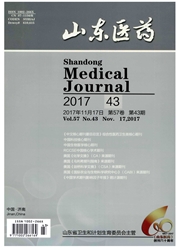

 中文摘要:
中文摘要:
目的探讨口腔扁平苔藓(OLP)患者血清差异蛋白表达及意义。方法选择6例OLP患者(观察组)和6例健康志愿者(对照组),抽取空腹静脉血后采用苯酚抽提法提取血清蛋白,Bradford法测定蛋白含量,双向荧光差异凝胶电泳法分离检测差异蛋白点,液相色谱-质谱联用技术鉴定差异蛋白。选择其中研究较少的蛋白,采用Western blotting法检测两组蛋白相对表达量。结果两组血清差异蛋白点(583±183)个,其中重复性好的蛋白差异点20个,质谱分析蛋白序列鉴定出12种蛋白质。12种蛋白质中,7种(补体C3、激肽原、α-2-巨球蛋白、人抗凝血酶Ⅲ、分泌型Ig A、补体C9、β-1-金属结合球蛋白)在观察组血清中表达降低,5种(结合珠蛋白、铜蓝蛋白、载脂蛋白AⅠ、维生素D、人类因子B)表达升高。观察组血清补体C3和人抗凝血酶Ⅲ蛋白相对表达量均低于对照组,载脂蛋白AⅠ高于对照组(P均〈0.01)。结论 OLP患者血清中存在12种差异蛋白质,血清补体C3和人抗凝血酶Ⅲ蛋白表达均降低,载脂蛋白AⅠ表达升高,其发病可能与免疫功能降低及感染有关。
 英文摘要:
英文摘要:
Objective To detect the differentially expressed serum proteins in patients with oral lichen planus( OLP)and explore their significance. Methods Six OLP patients( observation group) and the matched health adults( control group) were selected and we drew their venous blood. Serum proteins were extracted by phenol extraction. The protein concentration was determined by Bradford method. Serum proteins were separated by two-dimensional fluorescence difference gel electrophoresis( 2-D DIGE),the differential proteins were identified by mess spectrometry and the expression of the proteins was detected by Western blotting in the two groups. Results In average,the number of differential protein spots was( 583± 183),during which,12 highly reproducible spots were selected for mass spectrometry identification. Of these 12 protein spots,the expression of seven proteins,including serum complement C3,kininogen,α-2-macroglobulin,human antithrombinⅢ,secretory Ig A,complement C9 and β-1-metal binding globulin( SHBG),was decreased in the observation group,the expression of five proteins including haptoglobin,ceruloplasmin,apolipoprotein A-Ⅰ,vitamin D and human factor B was increased in the observation group. Compared with the control group,the expression of serum complement C3 and human antithrombin Ⅲ was lower,and the expression of apolipoprotein A-Ⅰwas higher in the observation group( all P 0. 01).Conclusion There are 12 differential proteins in serum of OLP patients and the expression of serum complement C3 and human antithrombin Ⅲ is lower which shows that the development of OLP may be associated with immune and infection.
 同期刊论文项目
同期刊论文项目
 同项目期刊论文
同项目期刊论文
 期刊信息
期刊信息
